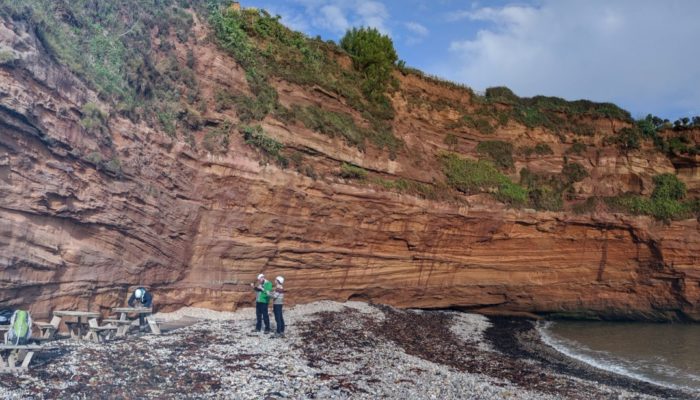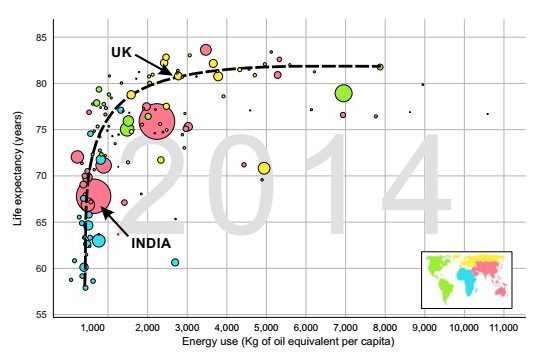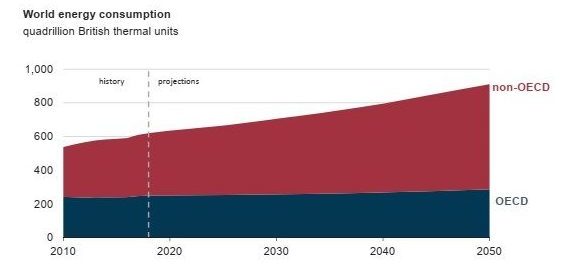
By Mike Simmons and Andy Davies.
It seems that geoscience is facing something of an existential crisis. The September 2020 issue of Geoscientist, the magazine of the Geological Society of London, contains a number of articles on the future of geoscience and its relevance to society. At the heart of the concerns are a drop in student numbers, with total 2019 undergraduate student enrolments down by 35% in UK universities from a high in 2014. Anecdotal evidence suggests similar trends in many other western countries. Numbers for some vocational courses are down by even greater percentages.
The consequences could be dramatic. Fewer students equals reduced income, leading to university departments facing budget cuts and possibly even closure. In turn, this leads to a reduction in research activity and the development of the science. At the same time, employers could find themselves facing a talent shortage, especially if the brightest young people choose other subjects instead of geoscience.
Why are young people apparently less interested in studying geoscience? We desperately need hard data to get to the answer of this question, but there are a number of factors, probably acting in concert. Perhaps it’s because the subject is still to fully embrace societal diversity. Perhaps it’s because the subject appears rather old-fashioned in an age of rapidly advancing technology. And perhaps it’s because of negative environmental perceptions associated with the extractive industries that geology supports, and even that these industries are rapidly coming to the end of their days (i.e. even if you wanted to work in industry, there aren’t any jobs). We are in a time of energy transition, with renewable energy sources forming an increasing proportion of the energy mix. What does that mean for the employment of geologists, not least stratigraphers, sedimentologists and palaeontologists, very many of whom have historically found gainful employment in the oil and gas industry?
In order to begin this analysis, we need an assessment of society’s appetite for energy and how this will be supplied. Access to affordable energy is essential for economic growth and social development (Lloyd, 2017) and the meeting of UN sustainable development goals. Put simply, people with access to greater access to energy live longer and more prosperous lives (Figure 1). The current global population is 7.8 billion, with UN projections suggesting that this will most likely rise to 9.8 billion by 2050 and 11 billion by 2100 (https://population.un.org/wpp2019/). Without very substantial changes in the efficiency of energy usage, a growing global population inevitably consumes more energy, especially as every nation seeks economic growth to ensure the prosperity and well-being of their citizens. Energy poverty is a very real issue. Currently, 940 million people (13% of the world population) do not have access to electricity. 3 billion (40% of the world population) have only intermittent access, at supply levels a fraction of that enjoyed in developed nations, and do not have access to clean fuels for cooking. This comes at a high health cost for indoor air pollution (https://ourworldindata.org/energy-access), leading to 3 million deaths per year. Therefore, because of population growth and economic growth, global annual energy demand is set to rise from current levels by around 50% by 2050 (www.eia.gov/ieo) (Figure 2).

Figure 1: Graph displaying life expectancy vs. energy consumption (data for 2014). Each colored bubble represents a country, size proportionate to population. A clear trend indicates that greater energy consumption relates to greater life expectancy. Based on free material from www.gapminder.org.

Figure 2: Projection of global energy consumption to 2050 (https://www.eia.gov/outlooks/ieo/). A rise of ~50% is predicted, mostly from developing nations.
How will this rising demand for energy be sourced if we are not otherwise simply to deny energy to large numbers of people, most likely those from developing nations? Doubtlessly renewable sources will form an increasing proportion of the energy mix, as electrification of heating and transportation promotes their greater use, especially as the price of their supply falls. The Energy Information Administration (EIA) project that by 2050, renewables will be the single most important source of energy (Figure 3). However, because of rising energy demand, almost all energy sources see rises in demand, such that by 2050 global energy will be supplied by almost equal proportions of oil, gas and renewables, and a smaller proportion of coal, plus nuclear. The EIA projections can be compared with those of other organisations (e.g. BP Energy Outlook, 2019; McKinsey, 2019), but although there are differences in detail, none predict a significant collapse in the demand for gas and oil, with these forming part of a balanced energy supply alongside renewables. Even in scenarios which see a rapid transition towards renewables, 700 billion barrels of oil are required to meet demand between now and 2040 (Figure 4). To put that in context, that’s as much oil as we have already found and used in the last 20-30 years or so. Some of that 700 billion will come from existing discoveries, but a large part of it remains to be found.

Figure 3: Projected primary supply source to 2050. By 2050, renewables will have become the most important energy source, but other energy sources remain an important and significant part of the energy mix (https://www.eia.gov/outlooks/ieo/).

Figure 4: Future oil demand in a variety of energy transition scenarios (BP, 2019). Even in a rapid transition scenario, oil demand is forecast at 80 million barrels per day in 2040. That translates to a demand for 700 billion barrels between now and 2040.
Why does the energy mix continue to be diverse over coming decades? Discussion of all technological reasons why renewables cannot quickly and totally replace hydrocarbons as an energy source are beyond the scope of this brief note (see Mackay, 2009 for a comprehensive discussion). However, key issues relate to energy density (e.g. to power an aircraft engine, or industrial machinery), geopolitics, costs, intermittent supply and storage, and the capital intensity of the energy system. Our infrastructure is dominated by machines and buildings that are relatively long lived. Cars tend to last at least 10 years before being scrapped; power stations can operate for 30 years or more. This acts as a brake on the pace at which new sources of energy can grow. Moreover, 85% of current global energy supply comes from hydrocarbons. With fossil fuels accounting for 11,865 mtoe of energy supply, it would take a reduction of more than 1 mtoe a day, to bring hydrocarbon usage down to zero by 2050. 1 mtoe is equivalent to the energy supplied by a nuclear power station or 1500 wind turbines. The challenge is indeed enormous.
Therefore, and acknowledging that there will be those who will wish otherwise, oil and gas will be part of the energy mix for several decades to come. But this doesn’t mean business as usual. The industry will focus on reserves with the lowest carbon intensity to find and produce. Geoscientists, need to contribute to increasing the efficiency, and hence reduced carbon footprint, in obtaining these resources. In other words, getting the geology right. Because of its relevance to correlation and palaeoenvironmental interpretation, stratigraphy, sedimentology and palaeontology has always been at the heart of this. Practitioners of these subjects have key roles to play in everything from regional geology studies high-grading areas for exploration, to building accurate reservoir models (Figure 5), through to rigsite work, steering well trajectories so that production is optimized. Fewer dry wells and fewer poorly producing wells lead to a reduced carbon footprint.

Figure 5: Outcrop of a key reservoir analogue in South Devon. Studying such helps build better reservoir models that in turn leads to efficiency in hydrocarbon extraction, reducing carbon intensity of operations. Or the models can be used in modelling carbon storage repositories and in green energy projects such as hydrogen and geothermal.
Carbon capture and sequestration (CCS) is entering prime time and will only grow in importance (Stephenson, 2018; Ringrose, 2020). Secure storage will require geoscientists who can locate and model suitable subsurface repositories for CO2, and model the behaviour of CO2 injected into those repositories. Once again, important work for stratigraphers, sedimentologists and palaeontologists, alongside making subsurface models for hydrogen storage (a key future energy source) and geothermal energy projects.
As oil and gas companies transition into energy companies, many will increase their investment in wind farm technology. Determining the appropriate location for wind farms requires an analysis of numerous factors, but the geotechnical suitability of their installation locations is a key concern. For example, in the North Sea, the considerable variability in the nature of sediments resulting from Quaternary glaciations is a key challenge. On the Dogger Bank, technical challenges associated with a buried landscape of glacial and fluvial channels and thrusted moraine complexes (Cotterill et al., 2017) must be overcome. Detailed sedimentological and stratigraphic understanding support such geotechnical endeavours.
Outside of industry, the need for geoscience never ends, if we are to meet the challenge set by one of the founders of the subject, Georges Cuvier, who encouraged us to “burst the limits of time”, meaning to envisage the history of the Earth and life upon it, and the mechanisms by which internal and surface Earth processes operate. That challenge is now being taken to our neighbouring planets. This note has focussed on the practical societal needs for stratigraphers, sedimentologists and palaeontologists, but of no less importance is the wonder of geoscience, simply (although actually far from simple!), understanding the Earth for its own sake. And this has practical value too, if we wish to model the future impact of humankind on the planet, we need to look to the geological past for analogues. Stratigraphers, sedimentologists and palaeontologists are amongst the custodians and curators of Earth history, perfectly placed to advise on the future of the planet and those who live on it.
References:
BP Energy Outlook 2019. https://www.bp.com/content/dam/bp/businesssites/en/global/corporate/pdfs/energy-economics/energy-outlook/bp-energy-outlook-2019.pdf
Cotterill, C., Phillips, E., James, L., Forsberg, C.F., Tjelta, T.I. 2017. How understanding past landscapes might inform present‐day site investigations: a case study from Dogger Bank, southern central North Sea. Near Surface Geophysics, 15, 403-414.
EIA International Energy Outlook 2019. www.eia.gov.ieo
Lloyd, P.J. 2017. The role of energy in development. Journal of Energy in Southern Africa, 28, 54-62.
Mackay, D.J.C. 2009. Sustainable Energy – Without the Hot Air. UIT Cambridge Ltd, 366pp.
McKinsey Global Energy Perspective 2019. https://www.mckinsey.com/industries/oil-and-gas/ourinsights/global-energy-perspective-2019
Ringrose, P. 2020. How to Store CO2 Underground: Insights from early-mover CCS Projects.
Springer, 129pp.
Stephenson, M. 2018. Energy and Climate Change. Elsevier, 186pp

Stephen Crittenden
Nice summary of the energy situation but………hydrocarbons / fossil fuels are not just a source of energy. They are required for a huge and diverse mix of products required by humanity for living. Will our descendants curse us for burning the stuff rather than conserving it for other useful purposes? Geoscience is the foundation of human society – ranging from decorative stones, poetry, literature, religion (remember Stone Henge and of course St Peter the rock upon which the church of Christ is built), transportation routes, building stone, pottery etc etc – the list goes on and on. Why is geoscience so shunned (or perceived to be shunned) in present day society? I answer it is lack of communication of the importance of geoscience for the world today and the bad publicity associated with the envionmental damage caused by the few in the pursuit of wealth from raw materials / resources.
In my career I have noticed that the geoscientists I have worked with are fully environmentally aware and endeavour to work is an environmentally responsible manner – and by that I do not mean the “lip service” approach of many resource extraction companies ” no damage to the environment” blah blah blah. Of course the environment will be damaged, it is inevitable, but it has to be kept to an absolute minimum. That mitigation inevitably costs money and that expenditure is the limiting factor in most industrial concerns. Geoscience should be at the forefront of acknowledging that the impact of natural resource extraction has an environmental cost – the damage will never be zero, but it must be kept to an absolute minimum. Ethical and responsible geoscientists are required and it is that message that will change society’s perception of geoscience. How many pure geoscience courses include ethics within their subject matter? In the three Universities I have attended the answer is none of them!